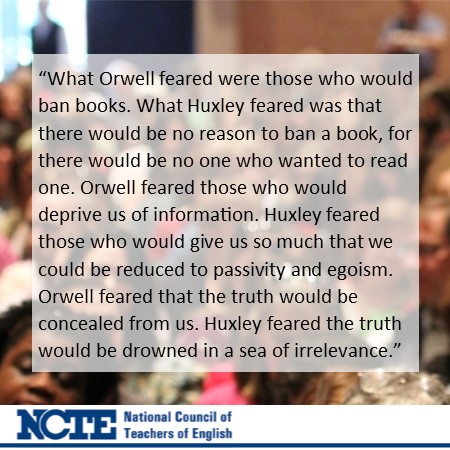Written by member Jeffrey Kaplan, this blog first appeared on member Steven Bickmore’s YA Wednesday blog.
In the highly acclaimed and ground-breaking book Teaching As A Subversive Activity (Delta, 1971), the late Neil Postman and his colleague, Charles Weingartner, wrote about the urgent need for educators to abandon conventional teaching practices – and instead, cultivate a classroom environment where true ‘critical thinking and inquiry’ were highly prominent, visible and recognized.
Easier said, then done.
As the current chair of the NCTE Standing Committee Against Censorship, I have spent the last few years coming to know a highly talented and gifted group of academics, educators, lawyers, writers, publishers and social activists who are all involved in the pursuit and defense of academic freedom – on the elementary, secondary, and even, collegiate level.
Topics like – academic freedom, book banning, and a term, new to me – trigger warnings (warnings that a work contains writing, images, or concepts which could act as a trauma trigger) – have permeated our conversations as we have met periodically – online and face to face – to discuss and carry out the charges of our committee – to provide guidance, support and ‘a shoulder to vent on’ – when educators, particularly public school teachers, find themselves face to face with “those who want to curtail the right of free speech and reading” from children and adolescents.
The conversations have been revealing, sometimes intense, but always, enlightening.
More importantly are conversations about the right of educators – even those who act as “loco parentis” in our elementary and secondary schools – to select and teach the kinds of books and writings they deem acceptable and appropriate for their students. Our conversations – freewheeling and free-spirited – have been most helpful in allowing all of us – to clarify our own thoughts about what is best for children and adolescents to speak, read, write and hear in their classrooms across this country.
As an educator – you too, will undoubtedly, find yourself – at one time or another – asking
“should I teach this book – or this essay – or this play – or this poem – to these students – even though some might find the words – or language – or thought – or theme – questionable? Or maybe, even reprehensible?”
Teachers – especially teachers in a public school setting – are no different from any other state employee. We want to keep our jobs, our steady paycheck and our reputation for fairness, responsibility and equanimity intact – so we live to see another day and keep our heads above water.
Still, we know that teaching – when done right, when all else is considered, and all our students’ immediate needs are met – safety, security, understanding, – is still a task – like no other – for our job is to uncover the truth and to allow our students to revel in its knowledge.
Like journalists, we know that we must always respect what we believe to be true – regardless of how uncomfortable the truth might make us feel – believe – or think.
Teachers must never feel that they should shy away from a controversial book or text or writing – just to play it safe – because they feel that by playing it safe, they will avoid the inevitable.
Yet, teachers should also know that taking a risk – that exposing students to an “edgy read with foul language and a harsh topic” – should not be taken lightly. They should know that when they venture into a “knowable unknown” – teaching a predictable controversial read – they should do so “with their eyes wide open.”
Simply, they should teach knowing that the possibilities of censorship are real, often imminent, and never pretty.
With that said, here are some do’s and don’ts for working with controversial reading matter in a public school setting with children and adolescents…
Share with Your Principal
Want to teach a text that you know will be controversial? Foul language? Graphic writing? Harsh themes? Let your principal know. No administrator likes to be surprised. So, get their thoughts – and permission, first. If they support, you’re half way home. If not, ask yourself – what are you willing to risk now?
Share with Your Colleagues
Maybe, your colleagues have already taught this ‘controversial text.’ Maybe, they wanted to – but didn’t have the ‘nerve’ to try. Or maybe, they have never heard of it – and now, are just as curious and as eager as you are. In any event, never hide. Let your colleagues know what you want to teach and why.
Share with Your Parents
When you feel the time is right, share what you want to teach with your students’ parents. Tell them what you want to teach, why and how. Most importantly, give them a heads up as to what they should know that might be controversial – language, descriptions, writing – so that they, like your principal, are not caught unaware – and as protocol usually permits, let them know that they have the option to not allow their child to read and/or participate in this controversial read and/or discussion – but not to deny the rest of the class their right to read.
Know Your Reason
Why do you want to teach this text – that might be considered controversial? Do you have a rationale? Do you believe it will add to your curriculum? To your students’ knowledge? Understanding? Be sure to always know why you are doing what you are doing – why you are making these choices – and that you can explain your choices to your students, colleagues, parents and administrators.
Seek Your Support
When you decide to teach a controversial text – and you need support – you should seek it. There are many organizations – for example, the National Council Teachers of English and the National Coalition Against Censorship – which are ready, willing and able to help you in support of your teaching and/or challenge to teaching a controversial work. Never assume you are alone; there are professionals ready to help.
Seek Your Professionalism
Teachers teach because they want to “make a difference.” They want to change lives, change thinking, and change the world. You can do that – by avoiding self-censorship – (not wanting to teach something because you fear “trouble,” – and by taking risks on works that otherwise might not be taught – but, can – with support, guidance and “teaching know-how,” – make a real difference in the lives of young people who are wrestling with real and difficult problems.
Seek Your Challenge
Reading, writing, thinking and speaking should never be passive. Young people should recognize that learning requires “stretching” and that coming to grips with difficult, but important issues and concerns is all part of growing up. So, together, you and your students should recognize the validity and value of how just one writer – an author, a playwright, a poet – even a cartoonist – can make a huge difference in the way we see the world. Never lose sight of a teacher’s mission to engage the world – no matter how uncomfortable, at times, it may be.
How lucky we are – as teachers, as parents, as writers, as social justice advocates – and just plain citizens – to have at our fingertips – through the magic of the World Wide Web – so many insightful, thoughtful and informative resources – to help us when we need more clarification in regards to our rights and responsibilities of teachers of social justice…
Resources to Help with Censorship Issues
National Council of Teachers of English Intellectual Freedom Center
National Council Teachers of English Standing Committee Against Censorship
National Council Teachers of English Position Statements on Censorship and Intellectual Freedom
National Coalition Against Censorship
Banned Books Week Coalition
NCAC Book Censorship in Schools: A Toolkit
Project Censored – The News That Didn’t Make The News
The First Amendment in Public Schools: A Resource Guide
People for the American Way – Schools and Censorship: Banned Books
The Huffington Post – School Censorship


